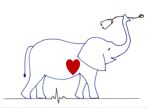Large Animal Cardiology Quiz
- While ausculting a horse, you note three heart sounds. The third sound is in late diastole, just prior to the typical “lub-dub”. What is this sound?
a. Pathologic S1
b. Pathologic S2
c. Physiologic S3
d. Physiologic S4
- Your patient is a 3-day old foal with a loud harsh, holosystolic murmur with a PMI on the right side of the chest. It is accompanied by an additional softer systolic murmur that you note cranially by the heart base on the left side. What is your top differential diagnosis?
a. Patent ductus arteriosus
b. Ventricular septal defect
c. Mitral stenosis
d. Bacterial endocarditis of the mitral valve
- Which of the following murmurs is consistent with a diagnosis of Aortic Insufficiency?
a. Crescendo-decrescendo (ejection quality) systolic murmur – PMI = Left 3rd ICS, below point of shoulder
b. Holosystolic plateau murmur, PMI = left 5th ICS, dorsal to olecranon
c. Long diastolic decrescendo murmur, PMI = left 3rd ICS, below point of shoulder
d. Harsh holosystolic plateau murmur, PMI = right 3rd-4th ICS, medial to triceps above olecranon
- Which pathology is most consistent with Tetralogy of Fallot?
a. Left Ventricular hypertrophy
b. Overriding aorta
c. Aortic stenosis
d. Atrial septal defect (ASD)
- Which of the following is FALSE regarding bacterial endocarditis in large animal species?
a. Ruminants are highly predisposed to lesions on the left side of circulation (mitral valve, aortic valve)
b. Shifting leg lameness, recurrent fever, and poor milk production are common clinical signs
c. Cattle may present with a history of traumatic reticuloperitonitis or pneumonia
d. Streptococcus species are a common pathogenic organism of bacterial endocarditis in cattle
- Which toxin source is well known to cause myocardial disease in the horse?
a. Rotting, decomposing feed or haylage
b. Red maple
c. Vitamin K antagonist rodenticides
d. Monensin
